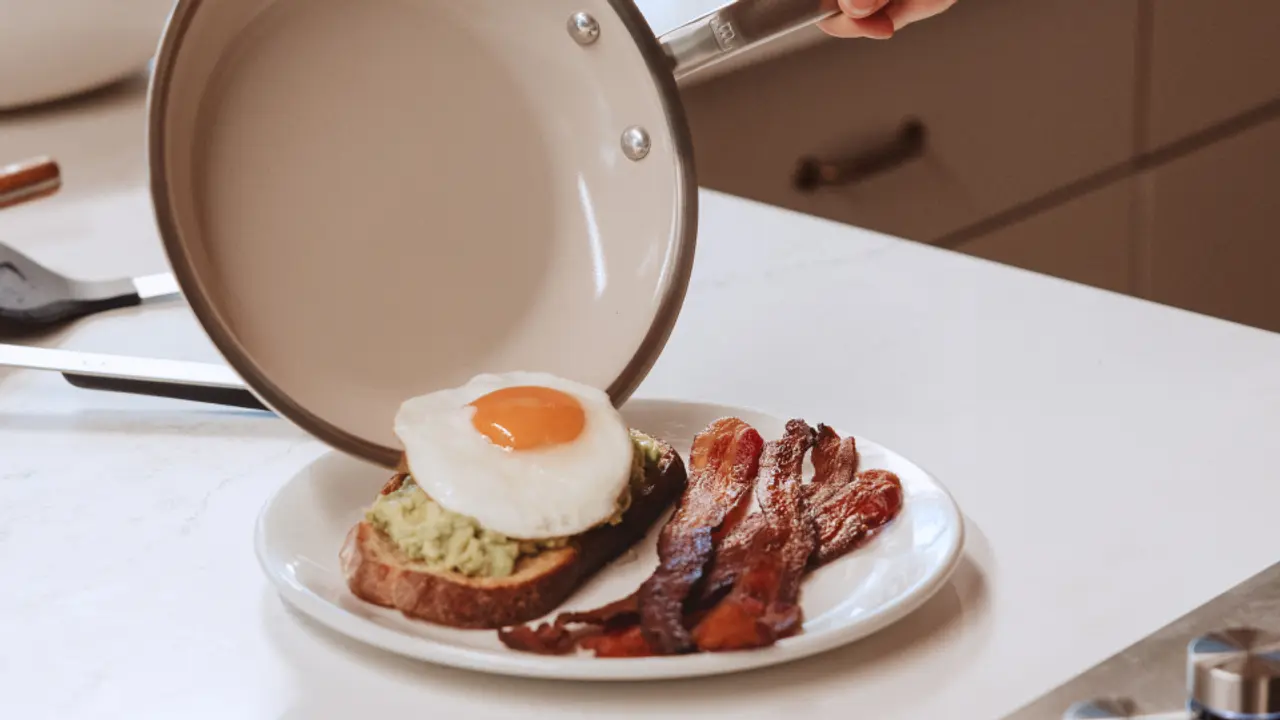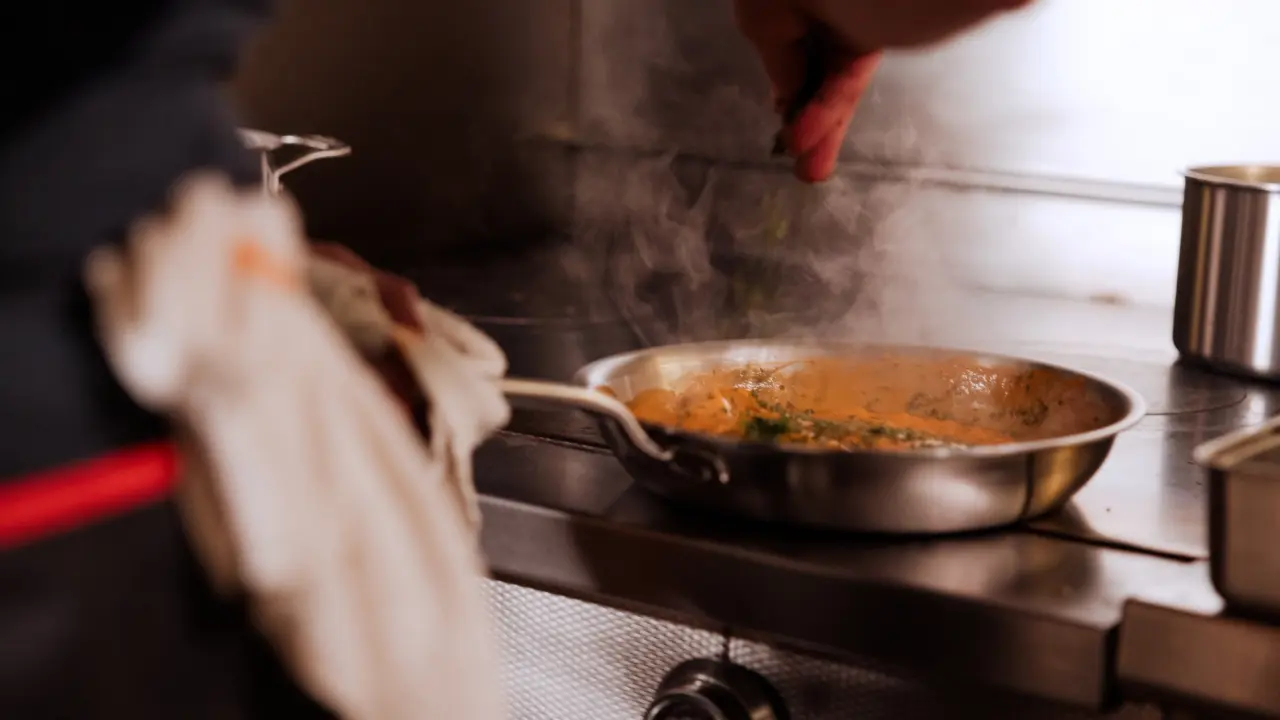When it comes to cookware, every material, style, and size has a role in your kitchen—and each has its own benefits and drawbacks. So if you’re trying to decide between non stick and stainless steel (two of the most popular and prevalent styles of cookware) we’ll make it easy for you: You should get both.
To make our case, we’ve laid out the types of cooking methods each one is best suited to, as well as any considerations to keep in mind. So without further ado, here’s why stainless steel and non stick each merit a place in your cookware collection.
Understanding Non Stick Cookware

When we talk about non stick cookware, we’re pretty much always referring to manmade non stick coating. Engineered to repel water and oil, traditional and ceramic non stick alike are excellent for cooking delicate or particularly stick-prone foods like eggs and fish. It’s also great for low-fat cooking, since you won’t need as much oil or butter to keep your food from sticking.
While non stick is one of the more affordable types of cookware, it’s also extremely variable in terms of quality. Luckily, ours is built to last—with several layers of professional-grade coating on top of our award-winning 5-Ply Stainless Clad, our ProCoat Non Stick Cookware and CeramiClad™ Non Stick both offer a frictionless cooking surface and a durable, even-heating base.
Advantages of Non Stick Cookware
- Due to its nonporous, hydrophobic (aka water-resistant) coating, food releases easily from the surface of non stick pots and pans.
- Because you need less oil or butter to keep food from sticking, non stick is ideal for low- or no-fat cooking.
- Minimal sticking means no burnt or stubborn messes to deal with, making for quick cleanup.
Considerations of Non Stick Cookware
- Due to the nature of non stick coating, even the highest-quality non stick pot or pan will begin to break down after a few years.
- Non stick coating isn’t meant for prolonged high-heat cooking, so it’s not the best for oven roasting or searing.
- Non stick coatings tend to be comparatively delicate, and aren’t suited to metal utensils or the dishwasher.
Best Uses for Non Stick Cookware
While non stick might not compare with carbon or stainless steel in a high-heat cooking competition, it does do a stellar job with sticky or delicate items like fish or fried rice. It’s also our go-to pan for cooking all manner of breakfast foods—think delicate crêpes, Dutch babies, scrambled eggs, omelets and more, without excessive cleanup.
Understanding Stainless Steel Cookware

We don’t want to know what our kitchens would look like without stainless steel cookware. As responsive to temperature changes as it is excellent at evenly circulating heat, high-quality stainless steel cookware is unmatched in its searing and other high-heat cooking abilities.
When we say high-quality, we’re talking about high-grade stainless steel that’s been layered or “sandwiched” with other metals like aluminum and ferritic 403, both of which we use in the construction of our Stainless Clad pots and pans. This makes for durable, long-lasting cookware with superior heat distribution.
Advantages of Stainless Steel Cookware
- Quality, high-grade stainless steel cookware is durable and resistant to warping, denting, and scratching, and should last for years with proper care.
- Stainless steel layered with ferromagnetic metals offers stellar conductivity and heat distribution.
- Stainless steel cookware is high-heat resistant and oven-safe (as well as grill-safe) so it can be used for everything from stir-frying to oven-roasting to even grilling.
- Stainless steel is nonreactive, so it’s safe to use with acidic ingredients.
Considerations of Stainless Steel Cookware
- Keep in mind that, unlike non stick, stainless steel cookware is not stick proof—meaning you’ll need to use oil or butter to keep your food from sticking (unless you’re boiling or steaming, of course).
- Because it’s more prone to sticking—and also because it gets so hot, so quickly—stainless steel takes a little time to get used to. That said, thousands of home chefs have learned to love it, and we bet you will too.
Best Uses for Stainless Steel Cookware
While highly versatile, stainless steel is perhaps best known for its searing abilities. You should use it whenever brown, crispy food is the goal, whether we’re talking about potatoes, tofu, or a bone-in ribeye. Because it’s so good at conducting heat, it’s also the perfect material for soups and stocks, bringing huge volumes of liquid to a boil in minutes.
Non Stick vs. Stainless Steel: How Do They Compare?

We don’t think you need to decide between owning non stick or stainless steel cookware. They’re both useful in their own distinct ways. However, if you’re really only looking to purchase a single pan, here are the main factors to consider.
Heat Distribution and Retention
While high-quality non stick cookware (like ours) does a great job distributing and retaining heat, it still doesn’t quite measure up to stainless steel in this particular area.
Stainless steel cookware—particularly stainless clad cookware—combines highly conductive metals like aluminum and aluminum alloy with layers of stainless steel, making for a pan with great heat retention and distribution. Non stick, on the other hand, has comparatively poor thermal conductivity and doesn’t stand up to sustained high heat, so it doesn’t fare as well in this category.
Durability and Longevity
While non stick made with a durable, dent- and warp-proof Stainless Clad base—like our CeramiClad™ and ProCoat—will last much longer than a lower-quality aluminum-base pan, the non stick coating is a different story. Even if you take excellent care of your pan, the coating will begin to wear down after a few years, thereby becoming less non stick. Stainless steel cookware, on the other hand, will last for decades with proper maintenance and care.
Cooking Versatility
Non stick and stainless steel are both wonderfully versatile cookware options. Stainless steel, however, has a slight edge over non stick—not only is it better at searing and roasting, but it’s also safe to use in the oven or on the grill.
While both our CeramiClad™ and ProCoat Non Stick are oven-safe and heat-resistant up to 550 and 500F, respectively, neither are meant to be exposed to blistering high heat for long—the sweet spot is medium-low to enjoy the non stick surface for years.
Maintenance and Cleaning
In this category, non stick comes out head and shoulders above stainless steel. For everyday messes with non stick, all you need is a gentle scrub with soapy water—no scouring or soaking required.
On the flip side, stainless steel is more prone to burning, rusting, and sticking, and requires a bit more elbow grease to clean. Since stainless is more durable than non stick, however, you won’t have to worry as much about damaging the finish with too much scrubbing.
Do You Need Both?

While you don’t have to buy both stainless steel and non stick cookware—especially if you’re trying to stick to a budget—we definitely recommend it if you can. Even if all you use your non stick for is a quick breakfast scramble, you’ll thank yourself for keeping it on hand.
Ready to Cook?
Non stick is forgiving, easy to use, and even easier to clean; while stainless steel is a versatile workhorse with incredible searing power. Whether you go for one or both, however, you’ll always get the best results with cookware that’s built to last. Whether you opt for our ProCoat Non Stick, CeramiClad™ Non Stick, and/or Stainless Clad pans, you're bound for cooking excellence.
























